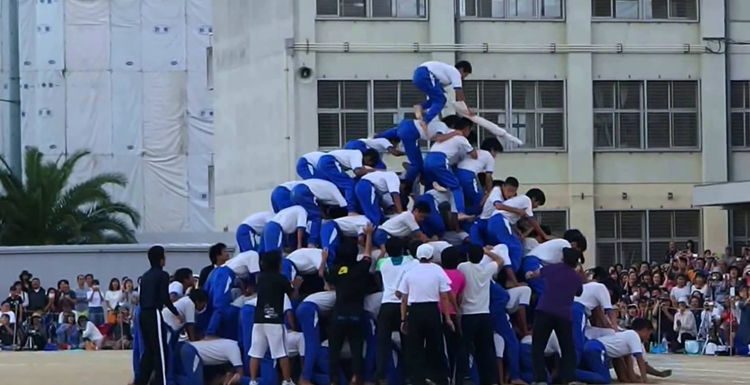Kumitaiso, a gymnastic formation in which students climb on top of one another to create a pyramid, has at the center of growing controversy in Japan, due to the high number of serious injuries reported by schools.
At its core, kumitaiso is a routine supposed to encourage teamwork and endurance among young students, and as such it has been a mainstay of annual school sport festivals across Japan. However, problems began to occur as the human pyramids organized by schools started getting higher and more difficult to support by the students at the bottom. Seeing dozens of students working together to create these complex structures is undoubtedly impressive to behold, which is why many schools kept pushing the limits over the years, with some devastating results. With hundreds of reported injuries reported every year, many in the Asian country are asking authorities to ban kumitaiso.

Photo: YouTube
In 2015, a junior high school student in Osaka suffered from a broken bone after taking part in a 10-tier kumitaiso pyramid, alongside 157 male students. Trainers must have known that considering the height of the formation and the total weight of the participants, the pressure on the bottom tiers would be excessive, yet they went ahead with the exercise anyway. Unfortunately, this was not an isolated case; in fact, despite concentrated efforts to have the practice banned in Japanese schools, 51-related injuries were reported between January and August of this year, in the city of Kobe alone. Over the last three years, the number of reported injuries totalled 123.
According to a 2016 news article by AFP, the annual number of student injuries related to kumitaiso exceeds 8,000, which is quite shocking, considering we’re talking about a gymnastic formation practised by children all the way from kindergarten through high-school. Still, despite campaigns by parents and doctors to have kumitaiso banned, teachers insist that the formation teaches students important lessons about teamwork and endurance.
The educational aspect of kumitaiso reportedly convinced the Japan Sports Agency not to enforce a blanket ban on the practice of gymnastic formation in schools, but there are many who insist it has become another way for rival schools to compete against each other, while completely disregarding children’s safety.
“There is a tendency to compete over the height of pyramids,” said Ryo Uchida, professor of sociology of education at Nagoya University. “In many cases the risks are being ignored.”
Three years ago, Uchida launched a petition calling on then-education minister Hiroshi Hase to regulate the size of kumitaiso pyramids, which would have dealt with the main risks of the practice, but Japanese authorities are yet to act. Some cities, like Osaka, have banned the practice, while others have enforced tier limits, but most have not.
Some people oppose the idea of regulating kumitaiso, because they value the sense of unity and accomplishment students experience, as well as the endurance it builds, while other believe student safety comes first. For now, the debate rages on.






